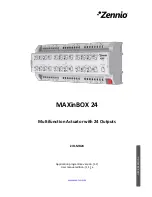
17
2016-01 ·
Zawór stabilizacji ciśnienia DHV
/ Constant pressure Valve DHV
Cleaning and
Passivation
Cleaning
All parts in contact with product must be cleaned at
regular intervals. Always observe the safety data sheets
issued by the cleaning agent manufacturers. Only use
cleaning agents which do not cause damage to the seals
and the inner parts of the valve. When the pipe is clea-
ned, the cleaning medium also flows through and cle-
ans the valve housings.
It is recommend to deactivate the control air pressure
during cleaning to achieve an optimal cleaning result.
With respect to the cleaning method and parameters
like detergents, temperatures, times and intervals, the
component manufacturer can merely make recommen-
dations but cannot provide any generally applicable
details. Method and parameters should be determined
and defined by the operator in accordance with the rele-
vant process.
The cleaning effect must be checked regularly by the
operator!
Cleaning Process Examples
Typical cleaning parameters in dairy opera-
tions
Example of a two-phase cleaning process:
• Sodium hydroxide and combination products based
on sodium hydroxide in concentrations from 0.5 % to
2.5 % at 75 °C to 80 °C.
• Phosphoric acid or nitric acid and combination pro-
ducts based on these acids in concentrations from 0.3
to 1.5 % at approx. 65 °C.
Example of a cleaning operation in one cleaning step:
• Formic acid and combination products based on for-
mic acid at up to 85 °C.
Typical cleaning parameters in breweries
• Sodium hydroxide and combination products based
on sodium hydroxide in concentrations from
1 % to 4 % at approx. 85 °C.
• Phosphoric acid or nitric acid and combination pro-
ducts based on these acids in concentrations from
0.3 to 1.5 % at 20 °C.
Czyszczenie i
pasywacja
Czyszczenie
Wszystkie części mające kontakt z produktem należy
regularnie czyścić. Należy przy tym przestrzegać infor-
macji w kartach charakterystyki producenta środka czy-
szczącego. Można stosować wyłącznie środki czyszczą-
ce, które nie uszkadzają uszczelek i części wewnętrz-
nych zaworu. Podczas czyszczenia rur obudowy
zaworu są również przepłukiwane i czyszczone.
Aby uzyskać optymalny efekt, podczas czyszczenia
zaleca się dezaktywację ciśnienia powietrza sterującego
dla zaworu.
Producent komponentów może jedynie rekomendować
sposób czyszczenia, np. środek czyszczący, tempera-
turę, czasy i interwały, nie może jednak udzielać
wiążących informacji. Użytkownik musi sam dostoso-
wać sposób czyszczenia do poszczególnych procesów.
Użytkownik powinien zawsze regularnie kontrolować
skuteczność czyszczenia.
Przykłady czyszczenia
Typowe parametry czyszczenia w mleczar-
niach
Przykład dla czyszczenia dwufazowego:
• Ług sodowy i produkty kombinowane na bazie ługu
sodowego w stężeniu od 0,5% do 2,5% w temp. 75°C
do 80°C.
• Kwas fosforowy lub azotowy oraz produkty kombi-
nowane na ich bazie w stężeniu od 0,3 do 1,5% w
temp. ok. 65°C.
Przykład dla czyszczenia jednofazowego:
• Kwas mrówkowy i produkty kombinowane na bazie
kwasu mrówkowego w temp. do 85°C.
Typowe parametry czyszczenia w browa-
rach
• Ług sodowy i produkty kombinowane na bazie ługu
sodowego w stężeniu od 1% do 4% w temp. ok. 85°C.
• Kwas fosforowy lub azotowy oraz produkty kombi-
nowane na ich bazie w stężeniu od 0,3 do 1,5% w
temp. 20°C.
Summary of Contents for DHV
Page 2: ...2016 01 Zawór stabilizacji ciśnienia DHV Constant pressure Valve DHV ...
Page 29: ......
Page 32: ......
















































